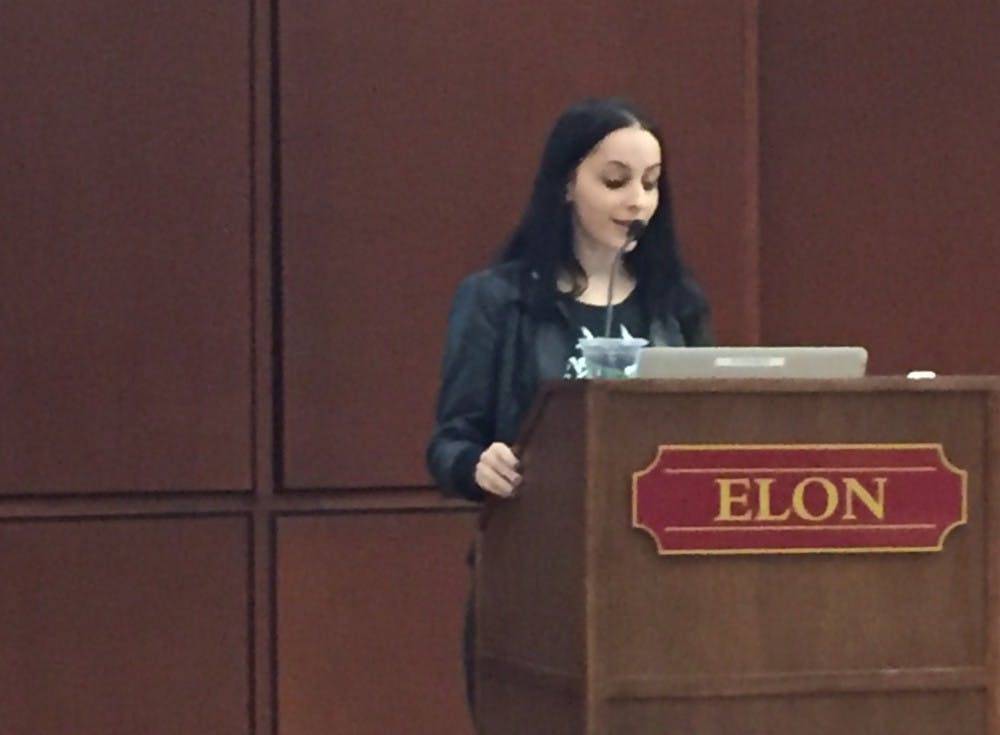For artist and journalist Molly Crabapple, art has given her a voice in a world overloaded with messages from all directions.
Crabapple spoke at Elon University Thursday night at 7:30 p.m. in the LaRose Digital Theatre in Koury Business Center. During her presentation, “The Connection Between Art and Politics,” she touched on a variety of topics, including the recent presidential election, the art community and the protests she’s both written about and drawn.
“Since I was four years old, I have drawn pictures," Crabapple said. "Art is both my obsession and my dream. My sketchbook is how I consume the world. I have been a working artist for the last decade. For four years, I have worked as a journalist too. In that time I’ve fused art and journalism together.”
To Crabapple, her art and her writing go hand-in-hand.
“I write, but I also use my sketchpad the way a photojournalist might use their camera,” she said.
The first time she used her sketches as documentation was when Occupy Wall Street protesters set up camp a block from her apartment. She could see them from her window, she said, and would sometimes give her drawings to organizers and later see protesters wielding them the same day.
"To see my art in the streets felt more vital than to see it in any gallery," Crabapple said. "I took the skills that I honed in these nightclubs, and I began to apply them to documenting protests. Same skills, right? See truly, draw fast, realize that everyone is at once subject and object. Same skills, but now, because I wasn’t drawing sexy women in feathers but instead was drawing tear gas, the skills were suddenly taken seriously.”
Crabapple spoke about the elitism she sees in almost all contexts around the world, from the government to college campuses and even the art community. She said that art must be made more accessible to those who are not considered the typical audience for art.
“Art must go out into the streets," she said. “All people want beauty, regardless of class.”
For Crabapple, art can also be used as a form of protests against abuses of authority and as a "powerful gesture of solidarity."
“Art is a need and art is vital," she said. "It is not trivial. And the art working class people make and love is often devalued … Art is for everyone. Art must be braver, art must dare more. Art must be both a refuge and a weapon.”
Some of the best art is art that is "threatening," but those pieces can't challenge viewers when "entombed in comfortable spaces where only those who agree with it will see it."
“Art needs to be out in the world, whispering, screaming, seducing and mocking, instilling us with empathy, showing us the world is far more complicated, painful and dazzling than we had previously imagined," Crabapple said. "As disappointment and violence spread, the antidote is a generosity that art at its best can inspire.”
Crabapple intertwined many themes throughout her remarks, especially how art can be utilized in unstable political periods as a way to educate people and unify.
“We need to fight for each other, every one of us," she said. "This world belongs to all of us and we’re not going anywhere ... In art and in life we must write better stories. And in this we have one advantage: history is on our side.”
Crabapple is based out of New York City, but has reported on issues across the United States and from around the world. She has reported onU.S. politics, solitary confinement, police brutality, Guantanamo Bay, the West Bank and the Syrian refugee crisis.
She is a contributing editor for VICE and her work has been published in the New York Times, CNN, Rhizome, The Paris Review, Vanity Fair, The Guardian, and The Daily Beast. Her 2015 memoir, “Drawing Blood,” was featured in the New York Times’ Sunday Book Review.
Crabapple has been the recipient of multiple honors, including the Yale Poynter Fellowship and a Front Page Award, for her writing. Her work on Guantanamo Bay was shortlisted for the 2013 Frontline Print Journalism Award. Crabapple was awarded the 2014 Gold Rush Award for her art, which has been showcased at the Museum of Modern Art, the Barjeel


